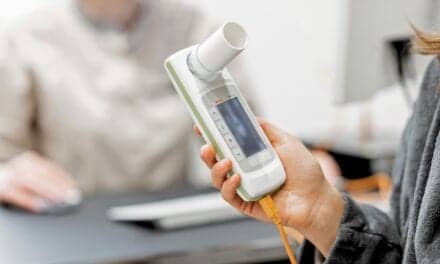Whole-body plethysmography can measure volumes not available through spirometry, although it is not appropriate in all circumstances.
By John D. Zoidis, MD
Spirometry is the standard method for measuring many lung volumes; however, it is not capable of providing information about absolute volumes of air in the lung. A different approach is required to measure residual volume (RV), functional residual capacity (FRC), and total lung capacity (TLC). Two of the most common methods of obtaining information about these volumes are gas dilution tests and body plethysmography.
Because they cannot be measured with simple spirometry, RV, FRC, and TLC, as well as airway resistance and airway conductance (Gaw), are considered elusive lung volumes. TLC is the total volume of air in the chest after a maximal inspiration. FRC is the volume of air in the lungs at the end of a normal expiration, when the respiratory muscles are relaxed. Physiologically, it is an important lung volume because it approximates the normal tidal breathing range. Outward elastic-recoil forces of the chest wall tend to increase lung volume, but they are balanced by the inward elastic recoil of the lungs, which tends to reduce lung volume. These forces are normally equal and opposite at about 40% of TLC.1 Loss of lung elastic recoil in chronic obstructive pulmonary disease (COPD), for example, increases FRC. Conversely, the increased lung stiffness seen in pulmonary edema, interstitial fibrosis, and other restrictive lung disorders decreases FRC. The difference between total TLC and FRC is called inspiratory capacity.
| Indications for Whole-body Plethysmography (Adapted from Respir Care.2) Diagnosis of restrictive lung disease • Measurement of lung volumes to distinguish between restrictive and obstructive processes • Evaluation of obstructive lung diseases, such as bullous emphysema and cystic fibrosis, that may produce artifactually low results if measured using other methods • Measurement of lung volumes when multiple repeated trials are required or when the subject is unable to perform multibreath tests • Evaluation of resistance to airflow • Determination of the response to bronchodilators, as reflected in changes in airway resistance, airway conductance, and thoracic gas volume • Determination of bronchial hyperreactivity in response to methacholine, histamine, or isocapnic hyperventilation, as reflected in changes in thoracic gas volume, airway resistance, and airway conductance • Follow-up assessment of the course of disease and response to treatment |
FRC has two components: residual volume (the volume of air remaining in the lungs at the end of a maximal expiration) and expiratory reserve volume. The RV normally accounts for about 25% of TLC.1 Normally, changes in the RV parallel those in the FRC. In restrictive lung disease and chest-wall disorders, however, RV decreases less than the FRC and TLC. In disease of the small airways, premature closure during expiration leads to air trapping, so the RV is elevated while the FRC and forced expiratory volume in 1 second remain close to normal. In COPD, the RV increases more than the TLC, resulting in some decrease in vital capacity.
Airway resistance can be measured directly using whole-body plethysmography, but is more commonly inferred from dynamic lung volumes and expiratory flow rates, which can be obtained more easily.1
The Plethysmography Procedure
During whole-body plethysmography, the subject is enclosed in a chamber equipped to measure pressure, flow, and volume changes. Secondary tests that can be performed during whole-body plethysmography include spirometry, bronchial challenge, diffusing capacity for carbon monoxide, single-breath nitrogen, multiple-breath nitrogen washout, pulmonary compliance, and occlusion pressure. Whole-body plethysmographs are usually found in pulmonary function laboratories, but they may also be used in cardiopulmonary laboratories, clinics, and pulmonology offices.
During whole-body plethysmography, the patient sits or stands inside an airtight chamber and inhales or exhales to a particular volume (usually FRC); a shutter then drops across the breathing tube. The patient makes respiratory efforts against the closed shutter, causing chest volume to expand and decompressing the air in the lungs. The increase in chest volume slightly reduces the box’s volume, thus slightly increasing the pressure in the box.
Selection Criteria
Indications for whole-body plethysmography include the diagnosis of restrictive lung disease, evaluation of obstructive lung disease, and measurement of lung volumes to distinguish between restrictive and obstructive processes (sidebar).2
Patients should not be subjected to whole-body plethysmography if they are mentally confused, experience muscular incoordination, have conditions that prevent them from entering the plethysmograph cabinet or adequately performing the required maneuvers, are claustrophobic, or require continuous oxygen therapy that should not be discontinued, even temporarily.2
Conclusion
In most cases, whole-body plethysmography is performed by the respiratory care technician. Providing attention to detail during the testing process and following the recommendations of the American Association for Respiratory Care (sidebar) will help to ensure the quality and validity of results.
RT
John D. Zoidis, MD, is a contributing writer for RT magazine.
References
1. Pulmonary function testing. In: Beers MH, Berkow R, Burs M, eds. The Merck Manual of Diagnosis and Therapy. 17th ed. Whitehouse Station, NJ: Merck; 1999:521-531.
2. American Association for Respiratory Care. AARC clinical practice guideline. Body plethysmography: 2001 revision and update. Respir Care. 2001;46:506-513.









